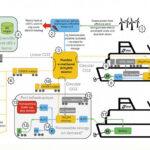
Maritime Power-to-X: Enabling a scalable green methanol economy
30th May 2025
Sigenergy: Innovating the future of energy
30th May 2025The challenge of building wind farms in Ireland

Building wind farms in Ireland presents several challenges due to regulatory, environmental, and social factors. While Ireland boasts significant wind energy potential, harnessing it effectively requires navigating complexities.
One major obstacle is the planning process. In Ireland this involves extensive environmental assessments, public consultations, and regulatory approvals. This can be time-consuming and costly, often leading to delays in project development. Ireland’s landscape is rich with many areas designated as protected habitats or cultural heritage sites. As a result, proposed wind farm sites may face opposition from environmental groups and local communities concerned about the impact on scenery, wildlife, and historical landmarks.
Reliance on turbulent weather
Ireland’s wind resources are abundant but variable, relying on turbulent weather patterns driven by the Atlantic Ocean. This intermittency poses challenges for grid stability and energy supply reliability requiring sophisticated forecasting and energy storage solutions to mitigate risks.
Ireland’s grid infrastructure faces constraints in certain regions, particularly rural areas where wind resources are abundant. The country’s electricity grid was designed to accommodate traditional, centralised power generation sources, such as fossil fuels. Integrating large amounts of wind power requires upgrades to transmission lines and substations to handle the variable nature of renewable energy sources and to facilitate the transmission of electricity from remote wind farm locations to urban centres. Rural or coastal regions with limited grid capacity, making it challenging to transmit electricity to urban demand centres. Upgrading transmission lines, substations, and grid management systems is essential to ensure the effective distribution of wind-generated power.
Offshore wind development presents even greater complexity. Ireland possesses vast offshore wind potential, harnessing this resource introduces a host of technical, regulatory, and logistical challenges. The harsh marine environment requires specialised equipment, engineering expertise, and substantial financial resources to construct and maintain offshore wind farms. Securing seabed leases involves navigating complex legal frameworks and coordinating with multiple authorities. Offshore projects must also address potential conflicts with other maritime industries, including fishing, shipping, and tourism. Coastal communities may raise concerns about visual impact, marine ecosystem disruption, or reduced access to fishing grounds, adding to the regulatory hurdles developers face.
Economic considerations also play a critical role. Wind energy costs have declined significantly in recent years, the initial investment required for turbine installation, grid connections, and supporting infrastructure remains substantial. Financing can be challenging, particularly for smaller developers. Developers must also navigate complex policy frameworks, which can change depending on government priorities or shifts in energy market dynamics. Securing stable revenue streams through power purchase agreements or government-backed incentives is essential to attracting investment and ensuring project viability.
Community engagement can influence the success of wind energy projects. While some communities support renewable energy initiatives, others may oppose wind farms due to perceived negative impacts on property values, noise, or visual aesthetics. Building trust with local residents through transparent communication, community benefit schemes, and active participation in project planning can help alleviate concerns and foster greater acceptance of wind energy developments. Without such efforts, opposition from local stakeholders can create delays or even halt projects entirely.
Despite these challenges, Ireland’s wind energy potential remains a significant opportunity for achieving its climate goals and reducing dependence on imported fossil fuels. By investing in improved forecasting systems, expanding grid infrastructure, and fostering collaborative relationships with communities, Ireland can unlock the full potential of wind energy. Strategic policy support, financial incentives, and technological innovation will be key to overcoming obstacles and ensuring a successful transition to a sustainable energy future. With careful planning and stakeholder cooperation, Ireland has the potential to become a net exporter of renewable energy, positioning itself as a leader in the global transition to cleaner power sources.
Colm McGrath
Head of Surety
Howden Insurance
To talk to Colm on bonding solutions for the Energy industry, call 086 8189702 or email colm.mcgrath@howdeninsurance.ie.



